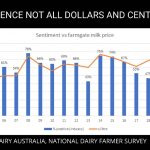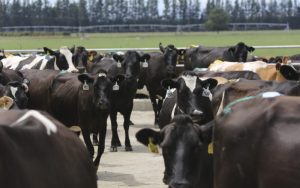
This reflects a wide ranging farm gate forecast price for the new season.
ANZ is forecasting a milk price of $5.75/kgMS for the new season, Westpac $6.30/kgMS, Rabobank $5.95/kgMS and ASB $6.50/kgMS.
Fonterra, for the first time, has announced a $1.50 range – $5.40 to $6.90/kgMS.
ANZ agriculture economist Susan Kilsby says the new dairy season brings heightened uncertainty, which is impacting milk price forecasts.
“New Zealand sourced product is commanding a premium in the global markets, but this premium is likely to be eroded as we start forward selling higher volumes of new-season dairy product.
“Prices typically weaken during July/August each year as buyers start to refocus on Oceania-sourced product.
“Global supply at this time of the season tends to be relatively high, as stocks tend to build in the Northern Hemisphere following their peak supply period, which occurs about May. At present we are selling the tail end of the dairy products manufactured from milk collected in the 2019- 20 supply season.”
Other NZ processors are also cautious in their forecast.
Synlait’s opening announcement is for a $6 milk price for next season. Open Country continues to pay its suppliers on a shorter time frame with its season divided into four sections. It has forecast a milk price range of $6.20 – $6.50/kgMS through to November.
Smaller processors like Oceania Dairy and Westland Milk will continue to pay a milk price linked to the Fonterra price plus a small premium.
ASB senior economist Chris Tennent-Brown says while the lift in whole milk prices in the last Global Dairy Trade was encouraging, over recent weeks the stronger NZD is an offsetting negative.
“We have been noting for a while the possibility that the milk price dips below $6.00/kg and have regularly suggested farmers prepare for this contingency.”
Milk production in the US and Europe continues to rise.
According to Fonterra’s latest global dairy update, US milk production increased 1.5% in April compared to the same period last year.
It says despite lower foodservice demand, US milk production continued to grow year on year. Milk production for the 12 months to April was 1.3% higher compared to the same period last year.
EU milk production lifted 0.9% in March compared to the same period last year as the EU season gets underway.
The largest production growth was seen in Spain (up 7.1%), followed by the Netherlands (3.0%) and Poland (1.9%) but decreases were experienced by Italy (2.8%) and the UK (2.4%).
With a demand slowdown in response to the pandemic, milk is being redirected towards powders and the European Milk Board is pushing for excess supply to be reduced through a voluntary supply reduction.
Dry bites milk production
Dry weather in the North Island caused a 10% drop in milk production in April, says Fonterra.
North Island milk collection in April was 51 million kgMS, down 9.9% on last April. Season-to-date collection was 844.6 million kgMS, down 2% on last season.
The co-op says effects of the drought are still being felt across much of the North Island.
“Soil moisture levels remain low, and pasture growth rates have slowed, both of which have impacted milk production.”
The drop in North Island collection was partly offset by South Island collection in April of 55.3 million kgMS, up 5.4% on last April.
Season-to-date collection was 602.6 million kgMS, up 1.8% on last season. Fonterra says the South Island has had a strong start to autumn, with milk production up strongly on the same time last year.
However, in the Central South, some farms are reported to have restarted water irrigation to alleviate dry soils.
The co-op’s total April milk collection was 106.3 million kgMS, 2.6% less than the same month last season. Season-to-date collection was 1,447.2 million kgMS, down 0.5% on last season.
Fonterra processes around 80% of NZ’s total milk.
Total NZ milk production in April was relatively flat, down 0.6% on a litres basis (down 0.8% on milk solids basis) compared to last April 2019.

























